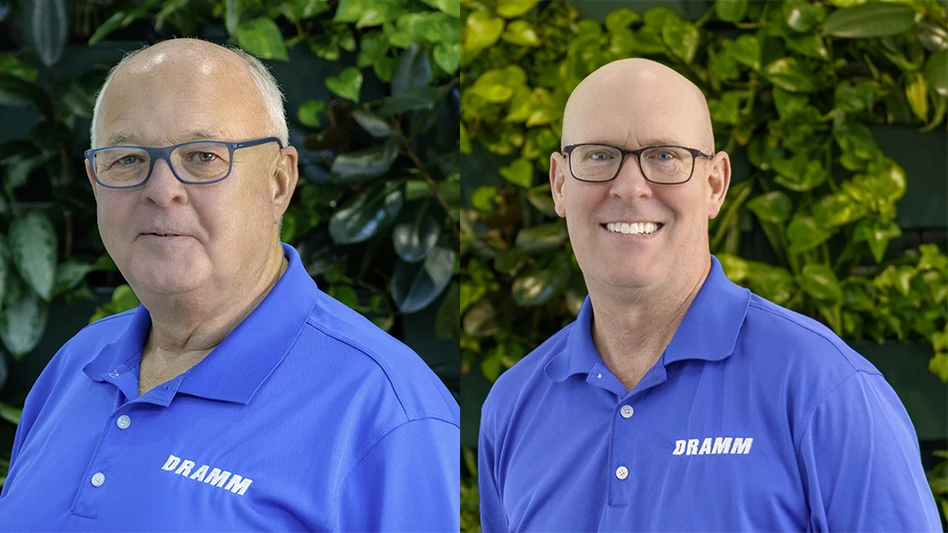

In last month’s issue we discussed how much water a substrate can hold and how much to replenish at various depletion levels, but not how quickly plants use water. A better understanding of plant water use will allow irrigation scheduling based on the plants rather than a set volume of water. There are several methods to determine how much water a plant uses in a day or a certain time period. Methods include determining leaching fraction (LF), using substrate moisture sensors, or by weight. Scheduling irrigation based on LF has been around for a long time. LF is the amount of water used over a certain period plus enough to cause a desired amount of leaching. To determine LF:
- a. Overhead Irrigation: before a normally scheduled irrigation event place 5 to 10 potted plants of the same species individually into larger containers, such as a bucket, that fits tightly around the pot so that water entering the bucket has to go through the substrate.
b. Micro-irrigation (individual plant): before a normally scheduled irrigation, place 5 to 10 potted plants individually into drip pans.
- Make sure there is a large enough gap between the bottom of the bucket or drip pan and the pot so that water is not reabsorbed by the substrate, a 1 inch tall ring of PVC pipe or a block of non-absorbent material can be used to provide the gap, or with some buckets the pot may rest on the rim of the bucket so that there is a gap underneath.
- a. Overhead: Do the same as 1a except with 5 to 10 of the same size but empty pots, no plant
and no substrate.b. Micro-irrigation: place 5-10 emitters individually into a container that will collect the expected volume of water for the
run time . - Run your irrigation system for the normal period, record the time.
- Measure the volume of water collected in each bucket/container.
- Average the volume collected from buckets with plants and average that collected from buckets without plants (or emitter containers), divide the average with plants by the average without plants, multiply by 100 to get LF (Table 1). See link 1 for an alternative method to determine LF.
- You can measure distribution uniformity at the same time if you increase the number of empty containers or emitter only measurements and disperse these throughout your irrigation zone. See links 2 and 3 for methods to determine distribution uniformity.
If the LF is different from your target you can calculate the correct
RunTimeDesired = RunTimeMeasured x (100 – LFMeasured) / (100 – LFDesired)

Using the LF data in Table 1, where a low LF was used, suppose the soluble salts have risen
RunTimeDesired = 45 x (100 – 10) / (100 – 25) = 54 minutes
After the 54-minute leaching

Many older recommendations target
We use sensors that measure substrate volumetric moisture content (SVMC- defined in last month’s article) to schedule irrigation. We have used both time domain reflectometry and capacitance sensors,
- Irrigate to cause leaching out of the drain holes.
- Wait 30 minutes to 1 hour to allow large pores to drain then measure SVMC with the sensor- this will give you container capacity (SVMCCC).
- Wait 24 hours (or some other desired time interval) and measure SVMC again (SVMC24)
- The difference between the measurements is how much water has been used by the plant and evaporated, or daily water use (DWU).
- To determine how much water to apply to replace DWU: Gallons DWU = (SVMCCC - SVMC24) x container volume acre-inch to apply = gallons DWU x 231 / pr2 231 is the constant to convert gallons to cubic inches, pr2 is the area of the container top.

This calculation over-estimates to a minor extent since you don’t fill pots up to the very top with
In steps 2 and 3, sample at least 10 pots for each species or similar water use group (Figure 1) and use the average in step 5. Step 2 should not be done every day, it defeats the purpose of improving irrigation practices to irrigate to drainage every day. Repeat step 2 monthly since CC often changes as plant roots fill pore spaces or substrates settle and shrink. Sampling with the handheld sensors (Figure 2) is very quick- just a few seconds each measurement- but still not something you want to do every day. Step 3 should be done each time you think the irrigation rate needs to be changed. When we used handheld sensors we would measure when there was a noticeable change in the weather (temperature,
As an example of the above calculations, suppose your SVMCCC = 43% (step 2), your SVMC24 = 36% (step 3) and you are growing in true 3 gallon containers (not all 3 gallon containers have an actual volume of 3 gallons) with a top diameter of 11 inches or a radius of 5.5 inches. For individual container
Individual container emitters:
- Gallons per plant DWU = (0.43 – 0.36) x 3 = 0.21 gallons
- RunTimeDesired = gallons DWU / emitter application rate
- RunTimeDesired = 0.21 / 2 = 0.105 hours = 6 minutes
Overhead irrigation
- acre-inch to apply = (gallons DWU x 231) / pr2
- acre-inch to apply = (0.21 x 231) / (3.14159 x 5.52) = 0.51
- RunTimeDesired = acre-inch to apply / overhead application rate
- RunTimeDesired = 0.51 / 0.75 = 0.68 hours = 41 minutes
Multiply acre-inch by 27,154 to determine the gallons per acre = 13,860

These calculations do not account for distribution uniformity. Divide runtime by distribution uniformity to correct.
By knowing the DWU, we can start grouping plants with similar DWU into similar irrigation blocks. Measuring and replacing the exact DWU for each crop in is impractical but measuring a representative species for similar DWU groups will allow more efficient irrigation scheduling. A grouping based on DWU (averaged over the season) for plants grown at our research nursery is shown in Figure 1. Most plants had a DWU less than 5% SVMC (see last month’s article). Since local and daily climatic conditions will affect DWU, the amount of irrigation to apply will vary depending on

Most plants are tougher than we give them credit. Even if we don’t completely replace plant DWU, many plants grow well and sometimes better when irrigated slightly on the dry side. For 7 years our irrigation experiments with 3-gallon shrubs used ¾ acre-inch daily irrigation as control with treatments to apply 100 percent DWU, alternating 100 percent DWU with 1 or 2 days of 75 percent DWU (100-75 percent DWU, 100-75-75 percent DWU). For 30 out of the 37 species we’ve studied, we found the same or better growth for these treatments as for the control (Figure 3), we found lower growth with the control
Irrigating with low to zero leaching not only reduces the amount of water used for irrigation but reduces the amount of runoff. Depending on species we have been able to reduce the amount of irrigation by 30-70 percent, the amount of runoff water by 30-85 percent and the amount of nitrate and phosphate in runoff by 30-50 percent. To attain results this high might be difficult for a commercial nursery with a much more diverse product mix but substantial reductions in water use, runoff and nutrient loss could certainly be attained.
When scheduling is done properly, it can result in more efficient water use, nutrients retained where they are available for plant uptake, reduced problems with alkaline water, reduced plant losses, improved plant growth and quality, shortened production cycle, less runoff and less off-site movement of water and nutrients.
Get curated news on YOUR industry.
Enter your email to receive our newsletters.
Explore the June 2018 Issue
Check out more from this issue and find your next story to read.
Latest from Nursery Management
- GIE Media Horticulture Group wins five regional 2025 Azbee Awards of Excellence
- Get to know Pat Reilly with NewGen Boxwood and the American Boxwood Society
- Terra Nova Nurseries introduces rust-free and disease-resistant heucherella
- John T. Nickel, founder of Greenleaf Nursery Co., passes away at 89
- Three tours offered at 2025 Farwest Show
- Garden Media Group announces sixth annual Women in Horticulture Week
- Star Roses and Plants announces National Knock Out Rose Day
- The Growth Industry Episode 4: How federal budget cuts are affecting horticulture nonprofits







